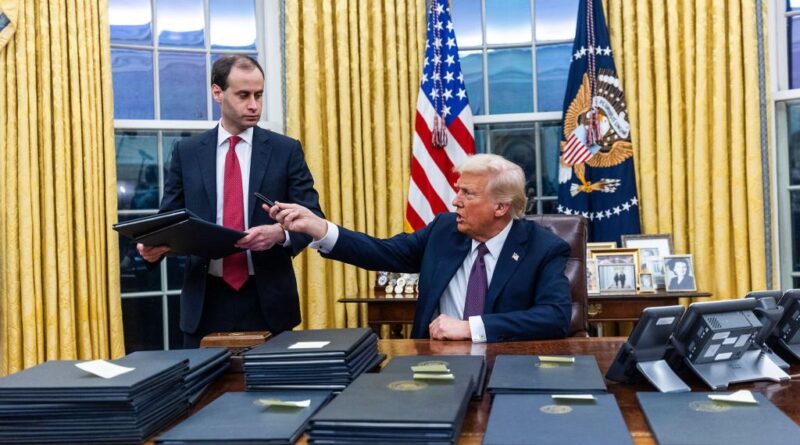Trump Hits the Ground Running: A Historic Start to His First 100 Days in Office

A headline from last week highlighted what Donald Trump might accomplish in his initial 100 days.
However, a more relevant focus might have been on his first 100 hours.
There’s a difference between hitting the ground running and experiencing Trump 2.0.
No modern president has stepped into the Oval Office as prepared and resolved to achieve significant goals swiftly as Trump has.
Days after taking the oath, he was already launching executive orders, pardons, appointments, speeches, meetings, and press interactions.
Among these activities was a landmark summit on artificial intelligence where private companies committed to a staggering $500 billion investment!
All of this unfolded before Trump took his show on the road on Friday, visiting the disaster-stricken areas in North Carolina and California.
Throughout the week, he was more accessible to the media than Joe Biden was over an entire year.
A significant portion of his early initiatives focused on his top priority: securing the border and apprehending criminal migrants for deportation.
‘A week is a long time’
He also delivered a video address to the Davos Economic Forum, where he presented business leaders with a proposition: manufacture in America or face hefty tariffs.
The striking contrast between the two presidents was exemplified by a large executive order Trump signed on his very first day.
This order cancelled nearly 80 directives from Biden, spanning topics from border security to DEI initiatives and environmental mandates.
The breadth of this action underscores Trump’s commitment to redirect the nation’s trajectory from the outset.
His tone was equally notable, stating, “The previous administration has entrenched extremely unpopular, inflationary, illegal, and radical practices within every federal agency and office.” His commitment was to “restore common sense to the Federal Government and unlock the potential of the American citizen.”
During his visits to western North Carolina, ravaged by Hurricane Helene, and fire-stricken Los Angeles, Trump assumed the roles of both comforter and persistent advocate for citizens.
In North Carolina, he criticized the Biden administration’s failure to provide adequate support, discussed the possibility of abolishing FEMA, and encouraged residents to voice their frustrations against insurance companies neglecting them.
In California, he sided with residents eager to return to their devastated homes, publicly urging LA Mayor Karen Bass to step aside.
“I just believe you need to let the people go onto their properties and initiate the process tonight,” Trump told the Democratic mayor.
Bass, whose performance has faced widespread criticism, acknowledged this but indicated it would take a week.
“A week is actually quite a long time, from my perspective,” Trump retorted emphatically, assuring her that “they are safe.”
This whirlwind of activity, which included a brief meeting with Governor Gavin Newsom, reflects Alexander Hamilton’s assertion in Federalist #70 that energy in the executive stands as “the leading characteristic in defining good government.”
This sentiment encapsulates Trump’s first week back in the Oval Office.
Of course, there were some challenges along the way.
A federal judge denied his attempt to eliminate birthright citizenship for children of undocumented immigrants, and law enforcement associations criticized his pardons for Jan. 6 rioters who attacked Capitol police.
Anchors ‘away’
Despite this, the most telling evidence of Trump’s swift start is the indecisive and unfocused reactions from his principal adversaries — Democrats and their media allies.
The media was often preoccupied with its own turmoil, highlighted by “CBS Evening News” anchor Norah O’Donnell being ousted, a known detractor of Trump.
Ratings plummeted, leading CBS to replace her with two co-anchors and a group of correspondents.
CNN, suffering from acute Trump Derangement Syndrome, is also undergoing staff cuts and anchor reshuffles, with Jim Acosta demoted to late-night hours.
His reported threat to leave the network was curious; while he compensates for his lack of talent with vitriol, finding new employment may be a challenge.
Internal strife continues to engulf The Washington Post and the Los Angeles Times as both ownerships strive to moderate their news coverage, attempting to step away from overt anti-Trump rhetoric.
Both faced backlash from staff after editorials endorsing Kamala Harris were prematurely published, leading to discord and a few writers resigning.
At The Washington Post, an earlier meeting Jeff Bezos had with Trump during the inauguration stoked workplace animosity, raising the age-old debate about whether the staff despises Bezos or Trump more.
The owner of the LA Times, Dr. Patrick Soon-Shiong, acknowledged the “struggle” of persuading his team to accept his decisions to widen the paper’s appeal beyond extreme leftism.
“I genuinely want us to be a trustworthy source for all Americans,” he conveyed to Fox News.
Just imagine objecting to fairness while touting a journalistic identity.
The New York Times shows no signs of easing its hostility towards Trump, with its front page delivering a relentless stream of criticism disguised as news.
“In His Return, Trump Embraces Pomp of Royalty,” proclaimed one prominent headline, while another noted “Trump Hurries To Test Limits of His Powers.”
A further headline questioned whether he would take punitive action against mayors and governors who protect criminal aliens.
These outlets consistently defended Biden by asserting his good health until the evidence became too overwhelming to ignore.
They also downplayed concerns surrounding the Biden family’s influence peddling, brushing aside revelations of $20 million funneled into Biden family accounts from foreign sources.
They defended Biden’s pardons for his family as preventive measures against potential “retaliation” from Trump, all while condemning Trump’s pardons as scandalous.
Headless party
The Democrats in Congress were taken aback by Trump’s swift actions, particularly given the absence of a clear party leader.
While Biden is indulging in ice cream somewhere, very few view Harris as a viable alternative.
Congressional leaders are being overshadowed by Trump’s spirited cabinet nominees, most likely set to receive confirmation from the Republican-controlled Senate.
Pete Hegseth’s selection as secretary of defense faced initial challenges but gained momentum, ultimately achieving his 51st vote when Vice President J.D. Vance broke a tie on Friday.
Three Republicans joined every Democrat in opposing his confirmation.
However, Democratic unity began to fracture when 12 senators and 46 House members supported the Laken Riley Act, permitting the deportation of undocumented immigrants accused of crimes without the need for a conviction.
This law, named in honor of a Georgia nursing student murdered by an undocumented immigrant, posed a challenge to how Democrats will navigate Trump’s border policies, which starkly contrast Biden’s platform.
While the representatives who backed the bill deserve praise, it signals that a significant portion of Democrats continues to overlook mounting public outrage regarding the open border, which was a central issue during the elections.
They will have other opportunities to reconsider their stance.
Trump plans to follow through on his commitment to vet individuals allowed entry and to deport those who shouldn’t be here.
And this won’t be some vague future plan; it’s happening now.
Buckle up, America.
The journey back to rationality has only just begun.



